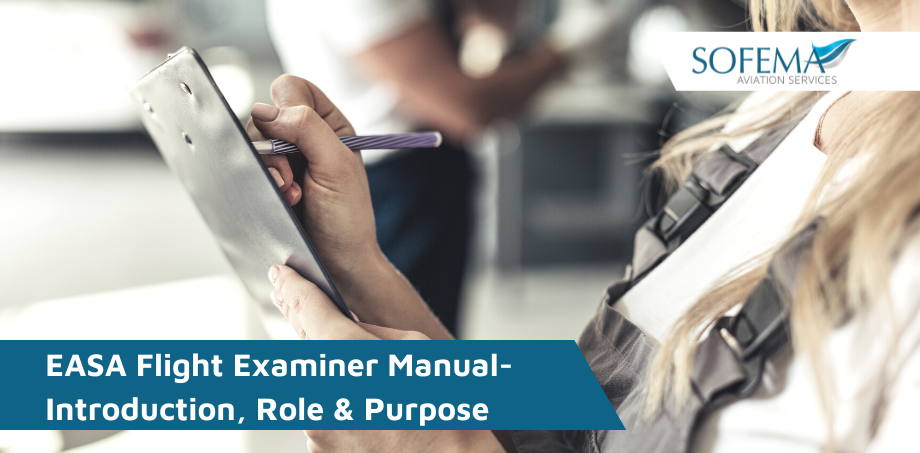Sofema Aviation Services (SAS) www.sassofia.com reviews EASA Flight Examiner Manual (FEM) Ver 1.0 Role & Purpose.
Introduction Flight Examiner Manual (FEM)
- The requirements for pilot Examiners in the European flight crew licensing system are set out in subpart K.
- (Part FCL.1000) of the Aircrew Regulation. This subpart deals with the common requirements for all Examiners and the specific prerequisites, experience, and standardisation requirements for each category of Examiner.
- The Aircrew Regulation also contains the Acceptable Means of Compliance (AMC) and Guidance Material (GM) for the initial standardisation of Examiners and the revalidation and renewal of Examiner certificates.
- The AMC material also contains a general guide to the content of a test.
Note: This Flight Examiner Manual (FEM) is not intended to be legally binding and is designed as a companion document to the Examiner standardisation requirements and guidance already set out in the Aircrew Regulation.
Standardisation Objective
In addition to the regulatory contents of the Aircrew Regulation, the purpose of this FEM is to give standardisation and best practice guidance to Examiners for the conduct of tests.
Note: Each competent authority may provide supplementary guidance and instructions specific to its territory.
- This information can be found in the Examiner Differences Document (EDD) and the content of this document should be covered in detail during Examiner standardisation and refresher courses.
- The EDD should be referenced by Examiners routinely when conducting tests on candidates for which the competent authority is not the same that issued the Examiner’s certificate.
FEM Structure & Use
The FEM contains the following modules:
Module 1: Common requirements for all examiner categories
Module 2: Test standards: Aeroplanes
Module 3: Test standards: Helicopters
Module 4: Test standards: Class ratings for SPA/TMG (excluding SPHPCA)
Module 5: Test standards: Type ratings
Module 6: Test standards: Mountain rating
Module 7: Instructor Certificate — Assessment of Competence
Module 8: Test Standards for Examiner Assessment of Competence
Module 9: Test standards: Senior examiners standardisation and assessments of competence for senior examiners
Module 10: Sailplane & Balloon
General Notes
All Examiners should be familiar with the FEM Module 1 (Common Requirements) and additionally the module(s) specific to their Examiner privileges.
Each module contains two guidance tables for the Examiner to use when conducting a test.
Concerning Skill Attitude & Knowledge
KNOWLEDGE – describes the desirable knowledge of the Candidate when applying the skills and attitudes necessary to comply with rules, and principles and to solve problems.
Knowledge is specific information required to enable a learner to develop and apply the skills and attitudes to recall facts, identify concepts, apply rules or principles, solve problems, and think creatively in the context of work.
SKILL – This cell describes the desirable skill required by Candidates to perform the test item.
Skill is the ability to perform an activity or action. It may be divided into three skill types: motor, cognitive and metacognitive skills.
ATTITUDE – Describes the attitude required by a Candidates to perform the test item. Attitude is a persistent internal mental state or disposition that influences an individual’s choice of personal action toward some object, person, or event and that can be learned.
Attitudes have affective components, cognitive aspects, and behavioural consequences.
- To demonstrate the “right” attitude, and a learner needs to “know how to be” in a given context.
Note: The intention is to provide typical, tangible assessment elements in order to evaluate the satisfactory performance of a task during a test.
Whilst this information is provided as guidance to assist the Examiner when assessing the requirements and the competencies required for satisfactory performance of each test item, appropriate to the license, rating, or certificate being sought. The Examiner is expected to use sound judgment when considering the overall competency of the candidate.
Next Steps
Follow this link to our Library to find & Download related documents for Free.
Sofema Aviation Services (SAS) provides Consultancy, Classroom, Webinar, and Online Training including the following course: EASA Regulation 1178/2011 Including EASA Part FCL Regulatory Training – 3 Days.
For additional details visit our website www.sassofia.com or email team@sassofia.com
Tags:
Acceptable Means of Compliance, Acceptable means of compliance (AMC), aviation, EASA, EDD, Examiner Differences Document, Examiners, Flight Examiner Manual, Flight Examiner Manual (FEM), Guidance Material, Guidance material (GM), SAS blogs, subpart K




